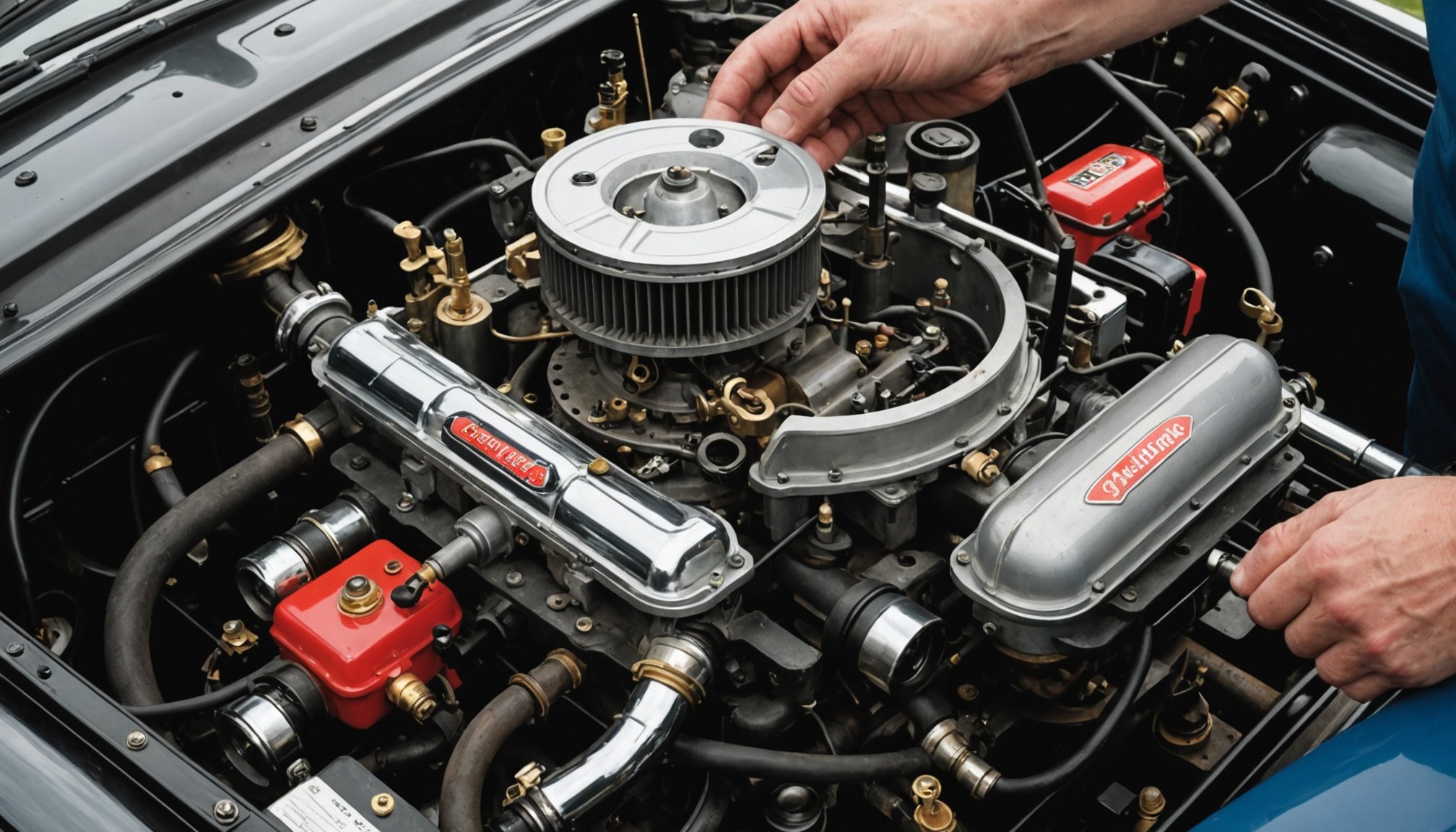Understanding Carburetors in Classic Cars
Carburetors remain a vital component of classic car engines. Understanding their function is crucial for proper engine tuning.
Overview of Carburetor Types
Classic UK cars primarily used various types of carburetors, each designed for specific engine needs. The most common ones include the single-barrel, dual-barrel, and quad-barrel carburetors. Single-barrel carburetors were predominantly found in smaller, less powerful engines. In contrast, dual-barrel and quad-barrel versions were reserved for more demanding engines requiring better performance and efficiency.
Also to read : Mastering the Art of Interior Restoration for Classic British Cars: A Comprehensive Guide
Role of the Carburetor
The primary function of a carburetor is to mix air and fuel in the correct ratio for combustion. Classic car engines rely heavily on this component to ensure optimal performance, as the air-fuel mixture impacts everything from power delivery to fuel economy. Properly functioning carburetors contribute to smoother operation and reduced engine knocking or stalling.
Importance of Proper Adjustment
Correct classic car engine tuning ensures that the carburetor is adjusted for optimal performance. Fine-tuning involves adjusting the idle speed, fuel mixture, and ensuring all components are clean and free from obstructions. Any deviation can lead to a decrease in efficiency, making regular maintenance essential for classic car enthusiasts.
Additional reading : Step-by-Step Guide: Installing and Customizing Aftermarket Car Security Systems in the UK
Tools Required for Carburetor Adjustment
Enthusiasts keen on refining classic cars often find adjusting the carburetor tools crucial to optimal performance. These tools help maintain and enhance vehicle operation. But what are the essential tools for carburetor adjustments?
Firstly, a screwdriver set is indispensable. It’s vital for tweaking the essential settings. You’ll need both flathead and Phillips variants. A carburetor synchroniser kit is also recommended. It’s perfect for balancing multiple carburetors. For classic cars, a specialist adjusting tools for classic cars set ensures tailored compatibility, essential for vintage UK models.
Specific recommendations for classic UK models include the Gunson Colortune Kit, which provides a window into the combustion chamber, enabling precise fuel mixture adjustments. The Motion Pro compound angle fuel/air screw wrench is favoured for its reach in tight spaces.
Safety should never be compromised. Equipped with basic safety gear like goggles and gloves can reduce injury risks during adjustments. Complement this with a reliable fire extinguisher nearby, especially when working with fuel systems. Routine maintenance tools, like torque wrenches and parts cleaners, help ensure everything runs smoothly. Adequate preparation, in combination with the right tools, ensures effective carburetor adjustments.
Step-by-Step Carburetor Adjustment Procedure
To effectively perform a carburetor adjustment, understanding the process is essential. It begins with the tuning instructions specified by your equipment’s manufacturer. Ensuring that you have the right tools and environment is key for precise adjustments.
Step 1: Prepare your tools and ensure the engine is off. Remove the air cleaner to access the carburetor.
Step 2: Refer to the tuning instructions to locate primary settings. Usually, these include the idle screw and the air-fuel mixture screw.
Step 3: For initial settings, screw in the mixture and idle screws gently until they stop. Then, back them out according to the specified turns in the manufacturer’s guidelines. This initial step ensures the carburetor is set to a baseline.
Step 4: Start the engine. Allow it to reach operating temperature for accurate tuning.
Step 5: Adjust the idle screw for a smooth engine operation. Focus on the measurements prescribed, like engine RPM.
Step 6: Turn the air-fuel mixture screw cautiously. Listen to the engine, aiming for a balanced, steady sound. Correct adjustment optimizes performance and fuel efficiency.
By meticulously following these steps and focusing on key settings and measurements, your equipment’s performance can be significantly improved.
Common Issues with Carburetors and Troubleshooting
Identifying carburetor problems in classic cars can be a daunting task, but knowing the signs can save you time. A poorly adjusted carburetor often shows symptoms like rough idling, poor acceleration, and an unusual increase in fuel consumption. Recognising these patterns helps you pinpoint the needed adjustments.
Classic cars may also suffer from mechanical issues such as leaky gaskets, clogged jets, or malfunctioning floats. These problems are prevalent due to age and wear, inevitably affecting the vehicle’s performance. Regular maintenance and inspection are key in preventing these issues from escalating.
Step-by-Step Troubleshooting Guide
-
Check for Vacuum Leaks: Spray a carburetor cleaner around the base and listen for any change in engine sound. A change indicates a vacuum leak.
-
Inspect the Fuel Level: Ensure the float is correctly adjusted to manage the fuel level appropriately. An incorrect fuel level can cause your car to stall or flood.
-
Look for Blockages: Examine jets and passageways to make sure they’re unclogged. Cleaning them with a suitable solvent can rectify many carburetor problems.
Remember, regular troubleshooting carburetors helps maintain your classic car’s optimal performance and prevents more significant issues in the future.
Tuning Tips for Optimal Performance
In the quest for peak performance enhancement, the art of carburetor tuning is indispensable. Effectively fine-tuning carburetors can significantly optimize your engine’s efficiency and power. The process requires attention to various components such as the idle mixture, idle speed, and main jet adjustments to match the engine’s requirements.
When you fine-tune a carburetor, understanding the engine load is crucial. What role does engine load play in carburetor tuning? It influences the air-fuel mixture requirements. Any changes, such as towing, introducing performance parts, or even varying terrains, can shift these needs. Hence, regular assessments and adjustments are necessary for consistently optimal outcomes.
Ambient conditions are another pivotal factor impacting carburetor performance. But how do ambient conditions affect carburetor tuning? Temperature, humidity, and altitude variations can alter air density, consequently affecting the air-fuel ratio. Cooler air, being denser, demands a richer fuel mixture, whereas higher altitudes may require a leaner setting due to reduced air pressure.
By applying these carburetor tuning techniques, one can ensure their engine responds efficiently to ever-changing demands and conditions, thereby maintaining exemplary performance and reliability.
Maintenance Advice for Classic Car Carburetors
Carburetor maintenance is crucial for classic car upkeep. Caring for these intricate devices ensures optimal performance and longevity. Here’s a handy checklist to keep your carburetor in top condition:
-
Frequent Inspection: Begin by regularly inspecting for wear or damage. Identifying small issues early can prevent larger problems in the future.
-
Cleaning Best Practices: Every few months, remove and clean the carburetor to prevent clogs. Use a specialized carburetor cleaner to eliminate build-up without damaging components. Allow each part to dry thoroughly before reassembly.
-
Idle Adjustments: Regularly check and adjust the carburetor’s idle speed. If the vehicle idles roughly, it might be time to tweak the mixture settings. This is critical for maintaining smooth operation and fuel efficiency.
Knowing when to seek professional help is equally important. If adjustments or repairs seem complicated, or if performance issues persist after maintenance, it may be wise to consult a professional. Experts can handle intricate repairs and ensure that every adjustment is precisely made. By following these guidelines, you can be confident in your ability to maintain your classic car’s carburetor, sustaining its charm and efficiency for years to come.











